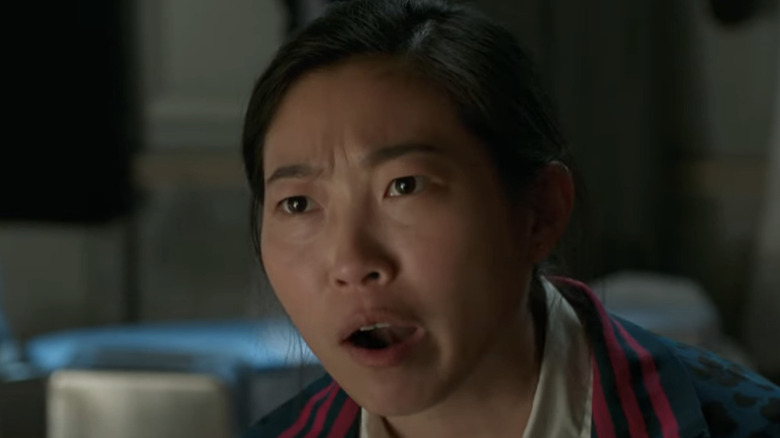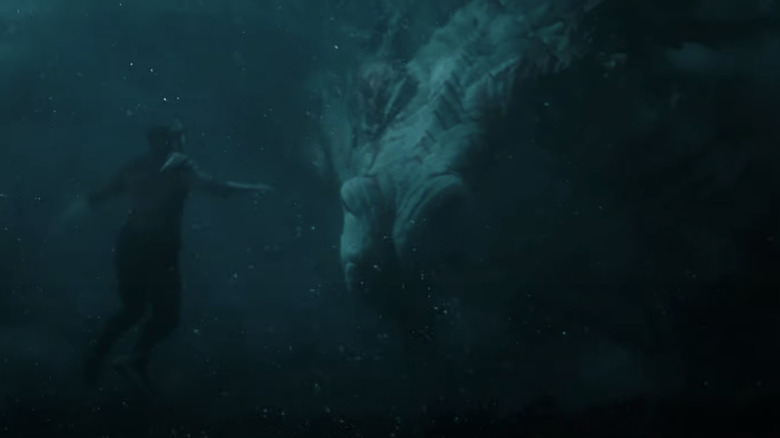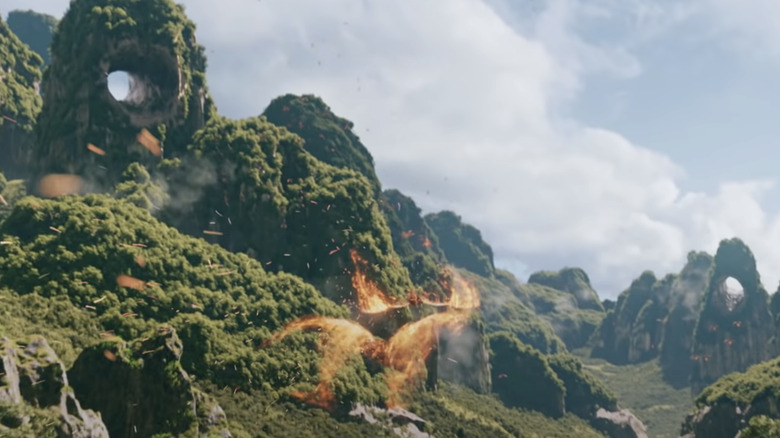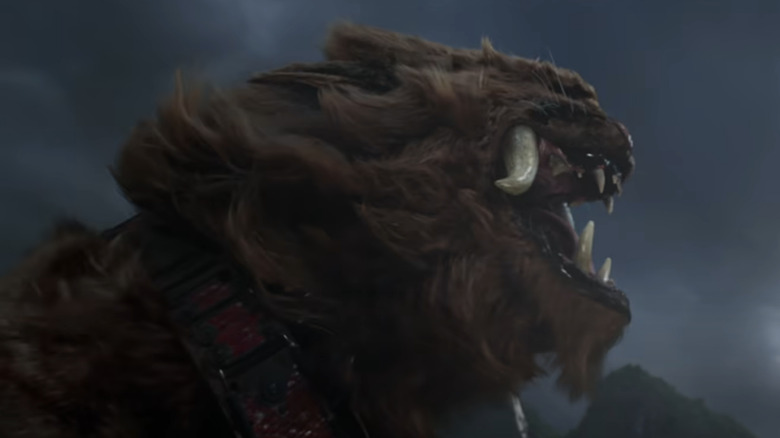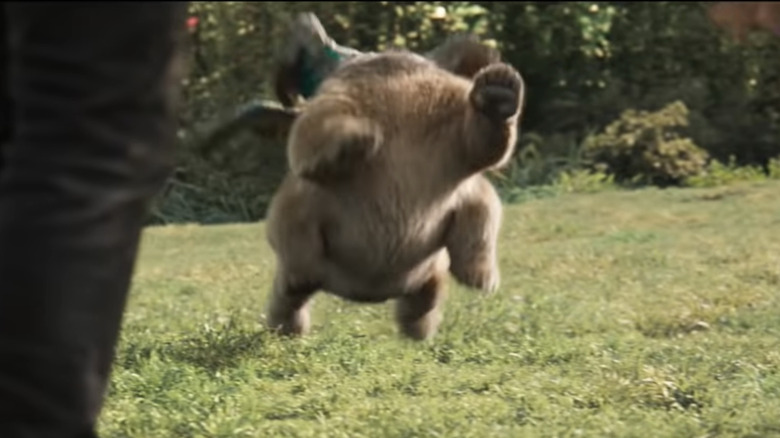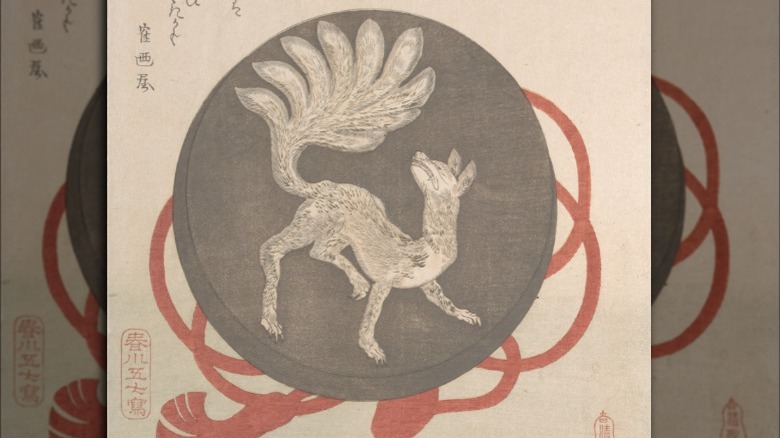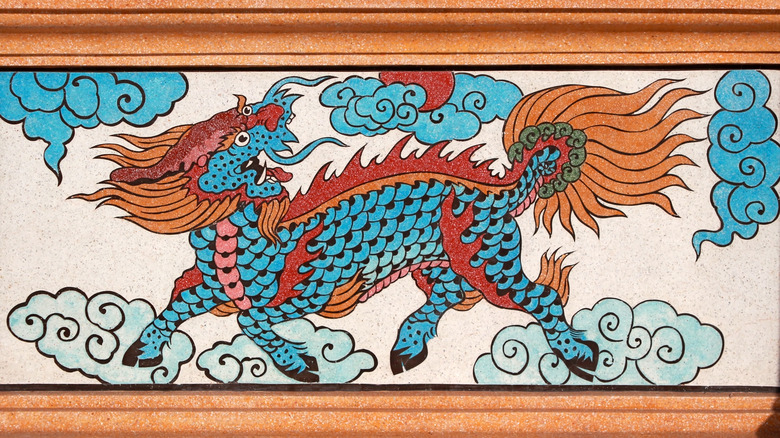All Of The Incredible Creatures In Shang-Chi Explained
We may receive a commission on purchases made from links.
"Shang-Chi and the Legend of the Ten Rings" is the latest release from the Marvel Cinematic Universe, and is yet another visual masterpiece from the popular franchise. The film follows Shang-Chi (Simu Liu), a man trained to be a hardcore martial artist by his father Xu Wenwu (Tony Leung), who becomes obsessed with infiltrating the mystical village called Ta Lo after his wife is killed. After completing a traumatizing mission as a young teen, Shang-Chi runs to San Francisco, takes the name Shaun, and lives a quiet life with his best friend Katy (Awkwafina).
One day, Wenwu's fierce warriors — called the Ten Rings — find Shang-Chi and attack him, forcing him to reveal his amazing fighting skills and return to the life he left behind all those years ago. Not only does "Shang-Chi and the Legend of the Ten Rings" feature adrenaline-pumping fighting scenes and post-credit sequences with exciting peeks into the future, but Ta Lo shows us a whole world full of stunning creatures, many of which come from classic Chinese mythology.
Here are all of the creatures featured in "Shang-Chi and the Legend of the Ten Rings."
Dragons
The most recognizable mystical being in "Shang-Chi and the Legend of the Ten Rings" is the dragon. Dragons are commonly seen in Chinese culture and storytelling, from the ones seen during Chinese New Year celebrations to the 16th-century classic Chinese novel "Journey to the West," which features the son of a Dragon King as a main character.
Much like The Great Protector is portrayed in "Shang-Chi and the Legend of the Ten Rings," dragons are commonly depicted as powerful, even magical beings who have domain over the natural world. According to Britannica, Chinese dragons were believed to live in water and take to the skies and were seen more positively than their European counterparts. "Ancient Chinese cosmogonists defined four types of dragons: the Celestial Dragon (Tianlong), who guards the heavenly dwellings of the gods; the Dragon of Hidden Treasure (Fuzanglong); the Earth Dragon (Dilong), who controls the waterways; and the Spiritual Dragon (Shenlong), who controls the rain and winds," the outlet wrote. "In popular belief only the latter two were significant; they were transformed into the Dragon Kings (Longwang), gods who lived in the four oceans, delivered rain, and protected seafarers."
Though there have been many variations to the outward appearance and abilities of dragons, they remain a central symbol in Chinese culture.
Fenghuang
Another of the more familiar-looking creatures seen in "Shang-Chi and the Legend of the Ten Rings" is the Fenghuang, which is often compared to the Western mythological phoenix, though the two aren't synonymous. The Fenghuang is an immortal bird that's often paired with the Chinese dragon as representing yin and yang to symbolize the balance in the universe. Fenghuangs are associated with harmony, political prosperity, and world peace.
Physically, the ancient Chinese dictionary called the "Shuowen Jiezi" describes the Fenghuang as having the body parts of several different animals, including the breast of a goose, the neck of a snake, the tail of a fish, the forehead of a fowl, the back of a tortoise, the hindquarters of a male deer, the face of a swallow, and the beak of a rooster, as explained by Britannica. They're also typically depicted with a mixture of red, green, yellow, white, and black colors, and are sometimes shown as fireballs — which may be where the confusion between Fenghuangs and phoenixes comes from.
Chinese Guardian Lions
In "Shang-Chi and the Legend of the Ten Rings," some fierce lion-like creatures are featured heavily in the battle scenes. These powerful beasts are equally known as Imperial guardian lions, Shishi, lion dogs, or foo dogs, and are typically seen as traditional Chinese architectural features that provide protection over sacred places, according to Britannica. Although the guardian lions shown in the film have prominent fangs, glorious furry manes, and are adept at fighting, the creatures aren't historically known for those features. Rather, they usually have big eyes, curly fur, and open mouths.
Guardian lions are always in male-female pairs and are believed to protect both the structure they're erected in front of as well as the people inside of it. The male lions are portrayed with a ball under one paw, and the female lions have a cub under one of theirs. This respectively represents the Chinese Empire and aspects of nurturing (via Fandom).
Additionally, according to Nazmiyal, "The lion is one of the divine beasts of Chinese mythology, with the ability to drive off evil spirits. According to Chinese lore, stone lions are able to cleanse shar chi, or 'poison arrows,' the negative force emanating from sharp corners, sickness, imposed authority, busy crowds and jarring structures."
Hundun
A standout character in "Shang-Chi and the Legend of the Ten Rings" is Morris, the faceless, six-legged creature with wings, who also happens to be adorably emotive. Morris is a type of being called a hundun, and while he's cute enough to be the newest MCU star featured on Disney merch, the origins of hunduns is a bit more complex than you may think.
The Chinese book "Classic of Mountains and Seas" describes a hundun known as Dijiang as "related or identical to a personification of cosmogonic chaos." The text also comments on Dijiang's physical appearance and the symbolism it holds: "It is tempting to see the image of Dijiang as that of the undifferentiated cosmos. His four wings, six legs, and lack of face and eyes indicate directionless movement. His sacklike physique encompassing emptiness suggests creation myths in which the universe comes into existence from the body of a god."
Huli Jing
Picture this: you're sitting there, enjoying "Shang-Chi and the Legend of the Ten Rings," when a Pokémon suddenly appears amidst the action. While the confusion is understandable, there was definitely no Ninetales featured in the film — it was actually the mythological creature that inspired the iconic Pokémon. The huli jing, or nine-tailed fox, are known for their shapeshifting abilities and can be either benevolent or malevolent spirits. Apart from their characteristic nine tails, they have four feet, make sounds similar to that of a baby crying, and typically appear in times of prosperity.
At one point, the myth of the huli jing evolved and the mythical foxes were known for being able to shapeshift into attractive women. Eventually, the term "huli jing" itself became a colloquialism for a seductress or temptress (via Academia Issendai). It was also believed that huli jing had to wait until they reached a certain age before they could change form or eventually ascend to Heaven.
A Chinese poet named Guo Pu wrote, "When a fox is fifty years old, it can transform itself into a woman. When it is one hundred, it becomes a beautiful woman or a shaman... They can know events from more than a thousand li away and are good at witchcraft, beguiling people and making them lose their senses. When they are a thousand years old, they can commune with the heavens and become heavenly foxes."
Qilin
Described in the film as a "weird horse," the final mythological creature shown in "Shang-Chi and the Legend of the Ten Rings" definitely looks like a horse-dragon hybrid, and it's known as a qilin. Similar to a chimera, the qilin is a hoofed being that appears to have the characteristics of several different creatures, including two antlers, long eyelashes, scales, a mane, and bright colors. Some historians have noted the comparisons of qilin to modern-day giraffes or even unicorns for their many similarities.
Qilins are known for being gentle omnivores, and are believed to have first appeared in the garden of the legendary Huangdi (Yellow Emperor) in 2697 BCE, according to Britannica. They were also known for being symbols of kindness, benevolence, and peace, and were often depicted near symbols of authority. Qilin-like creatures have been depicted many times in modern media — in anime series such as "The Twelve Kingdoms," in the "Dungeons & Dragons" game, and even in "My Little Pony: Friendship is Magic."
You can see all of the amazing creatures in "Shang-Chi and the Legend of the Ten Rings" for yourself in theaters.
